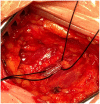Axillary vein access using ultrasound guidance, Venography or Cephalic Cutdown-What is the optimal access technique for insertion of pacing leads?
- PMID: 34887955
- PMCID: PMC8637085
- DOI: 10.1002/joa3.12639
Axillary vein access using ultrasound guidance, Venography or Cephalic Cutdown-What is the optimal access technique for insertion of pacing leads?
Abstract
We reviewed the different approaches used for central vein access during insertion of cardiac implantable electronic devices. The benefits and hazards of each approach (cephalic vein cutdown, axillary vein cannulation using venography and ultrasound) are discussed. Each approach has its advantages and hazards that need to be considered for the individual patient and balanced against the skills of the operator. The benefits of ultrasound guided venous access in reducing radiation exposure to the patient and implanter, avoiding the need for angiographic contrast and in minimizing the risk of pneumothorax and inadvertent arterial puncture are highlighted. Trainees should be taught each approach to deal with patient variability. Ultrasound guidance should be considered as a mainstream option for most patients.
Keywords: axillary vein; pacemaker; ultrasound guidance.
© 2021 The Authors. Journal of Arrhythmia published by John Wiley & Sons Australia, Ltd on behalf of the Japanese Heart Rhythm Society.
Conflict of interest statement
Authors declare no conflict of interests for this article.
Figures





References
-
- Calkins H, Ramza BM, Brinker J, Atiga W, Donahue K, Nsah E, et al. Prospective randomized comparison of the safety and effectiveness of placement of endocardial pacemaker and defibrillator leads using the extrathoracic subclavian vein guided by contrast venography versus the cephalic approach. Pacing Clin Electrophysiol. 2001;24(4):456–64. - PubMed
-
- Frykholm P, Pikwer A, Hammarskjöld F, Larsson AT, Lindgren S, Lindwall R, et al. Clinical guidelines on central venous catheterisation. Swedish Society of Anaesthesiology and Intensive Care Medicine. Acta Anaesthesiol Scand. 2014;58(5):508–24. - PubMed
-
- Bouaziz H, Zetlaoui PJ, Pierre S, Desruennes E, Fritsch N, Jochum D, et al. Guidelines on the use of ultrasound guidance for vascular access. Anaesth Crit Care Pain Med. 2015;34(1):65–9. - PubMed
-
- Beig JR, Ganai BA, Alai MS, Lone AA, Hafeez I, Dar MI, et al. Contrast venography vs. microwire assisted axillary venipuncture for cardiovascular implantable electronic device implantation. Europace. 2018;20(8):1318–23. - PubMed
-
- Jimenez‐Diaz J, Higuera‐Sobrino F, Piqueras‐Flores J, Perez‐Diaz P, Gonzalez‐Marin MA. Fluoroscopy‐guided axillary vein access vs cephalic vein access in pacemaker and defibrillator implantation: randomized clinical trial of efficacy and safety. J Cardiovasc Electrophysiol. 2019;30(9):1588–93. - PubMed
Publication types
LinkOut - more resources
Full Text Sources

